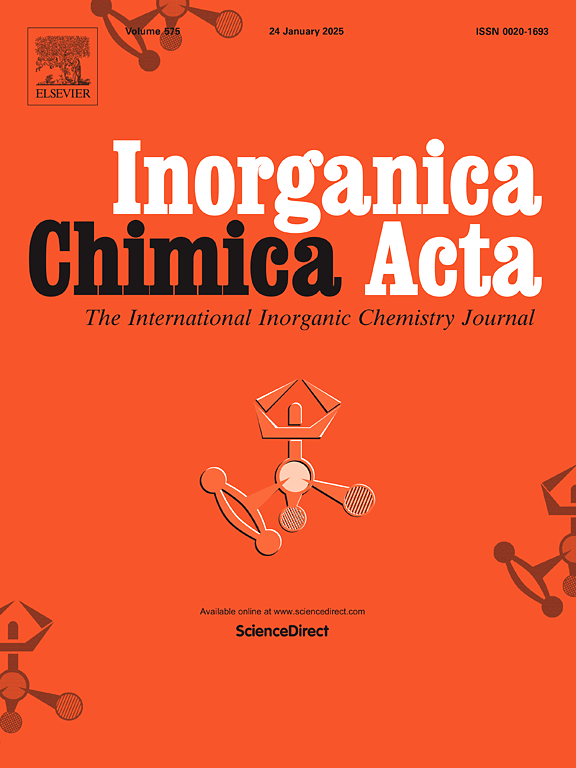Synthesis, crystal structure, spectral properties, and charge density analysis of 4-coordinate Bis[1-(4-N,N-dimethylaminophenyl)-1,3-butadionato-O,O′]copper(II)1
IF 3.2
3区 化学
Q2 CHEMISTRY, INORGANIC & NUCLEAR
引用次数: 0
Abstract
The reaction of 1-[4-(dimethylamino)phenyl]-1,3-butanedione (Hdapb) with copper(II) chloride produces bis[1-(4-N,N-dimethylaminophenyl)-1,3-butadionato-O,O′]copper(II), Cu(dapb)2 (I), with high yields. The title compound crystallizes exceptionally well, forming suitable crystals for X-ray crystallography and detailed electron distribution studies for copper. The copper atom can be treated as an isolated 4-coordinate atom with a single unpaired 3d electron. Contrary to expectations, the two dapb ligands bonded to the copper are inequivalent, characterized by unequal Cu![]() O bond lengths. A suitable model confirming the correct d-electron splitting and distortion of this d9-distorted square planar complex and establishing its spectral properties is proposed. R-free calculations were carried out to determine the optimal weighting parameters for the chemical equivalence and local symmetry restraints on the charge density. The charge density confirms the appropriate d-electron splitting for a distorted d9-square planar complex and establishes its compatibility with the complex's spectral properties. The UV–visible absorption spectra show a charge transfer band in addition to the expected d-d bands, whose energies deviate from the trend previously documented in the literature.
O bond lengths. A suitable model confirming the correct d-electron splitting and distortion of this d9-distorted square planar complex and establishing its spectral properties is proposed. R-free calculations were carried out to determine the optimal weighting parameters for the chemical equivalence and local symmetry restraints on the charge density. The charge density confirms the appropriate d-electron splitting for a distorted d9-square planar complex and establishes its compatibility with the complex's spectral properties. The UV–visible absorption spectra show a charge transfer band in addition to the expected d-d bands, whose energies deviate from the trend previously documented in the literature.

4-配位双[1-(4-N, n -二甲氨基苯基)-1,3-丁二酮-O,O ']铜(II)1的合成、晶体结构、光谱性质和电荷密度分析
1-[4-(二甲氨基)苯基]-1,3-丁二酮(Hdapb)与氯化铜(II)反应可高产出二[1-(4- n, n -二甲氨基苯基)-1,3-丁二酮-O,O ']铜(II), Cu(dapb)2 (I)。标题化合物结晶非常好,形成适合x射线晶体学和详细的铜电子分布研究的晶体。铜原子可以看作是一个孤立的4配位原子,只有一个未配对的三维电子。与预期相反,两个与铜结合的dapb配体是不相等的,其特征是CuO键长度不等。提出了一个合适的模型,证实了该d9畸变方形平面配合物的正确的d电子分裂和畸变,并建立了其光谱性质。通过无r计算确定了化学等效性和局部对称约束的最佳加权参数。电荷密度证实了扭曲的d9平方平面配合物的适当的d电子分裂,并确定了其与配合物光谱性质的相容性。紫外-可见吸收光谱除了显示预期的d-d波段外,还显示电荷转移带,其能量偏离先前文献中记录的趋势。
本文章由计算机程序翻译,如有差异,请以英文原文为准。
求助全文
约1分钟内获得全文
求助全文
来源期刊

Inorganica Chimica Acta
化学-无机化学与核化学
CiteScore
6.00
自引率
3.60%
发文量
440
审稿时长
35 days
期刊介绍:
Inorganica Chimica Acta is an established international forum for all aspects of advanced Inorganic Chemistry. Original papers of high scientific level and interest are published in the form of Articles and Reviews.
Topics covered include:
• chemistry of the main group elements and the d- and f-block metals, including the synthesis, characterization and reactivity of coordination, organometallic, biomimetic, supramolecular coordination compounds, including associated computational studies;
• synthesis, physico-chemical properties, applications of molecule-based nano-scaled clusters and nanomaterials designed using the principles of coordination chemistry, as well as coordination polymers (CPs), metal-organic frameworks (MOFs), metal-organic polyhedra (MPOs);
• reaction mechanisms and physico-chemical investigations computational studies of metalloenzymes and their models;
• applications of inorganic compounds, metallodrugs and molecule-based materials.
Papers composed primarily of structural reports will typically not be considered for publication.
 求助内容:
求助内容: 应助结果提醒方式:
应助结果提醒方式:


